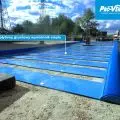How to combine medieval ruins with contemporary architecture and art? That was the question posed by the organizers of the international Art Cathedral competition. The challenge was to create a space for widely understood art on the grounds of the Irish Kells Priory, but without interfering with the historic building. The task was tackled by a team consisting of: Jeremi Ciechanowski, Iga Czaja (graduates of Gdansk University of Technology) and Hieu Trung Anh Phan, whose proposal made it to the final round of the competition.
The Art Cathedral competition organized by Young Architecture Competitions invited participants to rethink the function of historic religious buildings and ruins - to create space in them for cultural and artistic activities. The challenge was to transform Kells Priory, located in Ireland's largest medieval monastery. The organizers were looking for ideas that would connect historic spaces with the contemporary and create inspiring places for art making, performance and debate.
Kells Priory is one of the largest medieval monuments in Ireland
© YAC
Theproject had to include accommodations and studios for male and female artists, outdoor and indoor exhibition spaces, an auditorium and technical rooms. The newly built structures should be independent. The organizers stressed that the existing ruins could not be dismantled or demolished, trees removed and excavation work carried out.
The works submitted for the competition were evaluated by a jury consisting of: Manuel Aires Mateus (Aires Mateus), Valerie Mulvin (McCullough Mulvin Architects), Claudio Silvestrin (Claudio Silvestrin Architects), Edoardo Tresoldi, Emanuele Montibeller (Arte Sella), Alessia Salerno (Fondazione Prada), Michelangelo Pistoletto. The jury awarded three main prizes(First Prize went to Matteo Polignano), two gold prizes and three equivalent prizes. Meanwhile, the first on the competition shortlist was the Art Cathedral project by Jeremy Ciechanowski, Iga Czai and Huye Trung Anh Phan.
The development of the monastery grounds and the charaktersite pathway
© Jeremi Ciechanowski, Iga Czaja, Hieu Trung Anh Phan
reconstruction of the monastery in a contemporary form
The biggest challenge of the competition was for us to design a sizable volume in the medieval ruins, without disturbing or dominating them. We knew from the beginning that we wanted to interfere as little as possible in the existing structure in order to preserve the character of the architecture, whose origins go back as far as the 12th century. At the same time, aware of the great monastic foundation that once towered over the Irish landscape, we wanted to remind people of its existence. We decided to rebuild the monastery, preserving its scale and form, but already translated into contemporary language, the authors say.
The building with the green roof houses, among other things, art studios
© Jeremi Ciechanowski, Iga Czaja, Hieu Trung Anh Phan
inverted translucent gallery
The young architects, in order not to obscure the unique remains of the monastery with the new building, used the empty foreground within its walls, on which they placed the inverted and reflected form of the building. As they explain, they chose to reverse the massing to emphasize the contrast between the approach of medieval builders and modern architects. The cathedral, the main motif of the project, remained intact.
Inspired by the Irish foggy weather, we opted for a translucent polycarbonate facade, which emphasizes Kells' intricate history with its fragility, further exposing the ruins of the entire foundation, inviting them inside the art gallery. In turn, the building housing the studios, accommodation, and the auditorium, which also serves as a vantage point, is a reflection of the past - which is emphasized by the reflective, camouflaging material of mirrored stainless steel used on its facade, the architects say.
The entire premise is tied together by a cognitive path that is a strong color accent, leading to the green roof of the gallery building.
auditorium and vantage point
The building with a mirrored metal facade houses three different types of rooms on the first floor, while the second floor houses art studios with curtain walls providing views of the surroundings. The authors paid a great deal of attention to the axis of reflection, as they were keen to expose the restaurant and performance space.
The building houses studios, private rooms, a restaurant and an auditorium
© Jeremi Ciechanowski, Iga Czaja, Hieu Trung Anh Phan
In the 120-seat auditorium, we envisioned the curtain wall to be pulled apart so that in the light of the auditorium, the barrier between the outside and the inside disappears. When the stage is not being used for artistic performances, it is a public vantage point, providing an amazing view of the entire monastery establishment. From there, we can view the works of art that have been displayed outdoors, as well as inside the cathedral, the designers explain.
An exhibition space has been placed in the former cathedral
© Jeremi Ciechanowski, Iga Czaja, Hieu Trung Anh Phan
CLT technology
In order to interfere as little as possible with the existing surroundings, the authors opted for CLT technology and shallow-set slab foundations. The inverted form of the building naturally creates a green roof, harmonizing the landscape with the existing surroundings. The lightweight columnar structure provides a framework that transforms into open spaces.
The competition was a chance for us to face a unique heritage, an elaborate program and the notion of contemplative architecture. We are satisfied with our concept, which was intended to be uncompromising. We have learned a lesson from the Art Cathedral challenge and plan to face another international competition soon," the design team concludes.


































